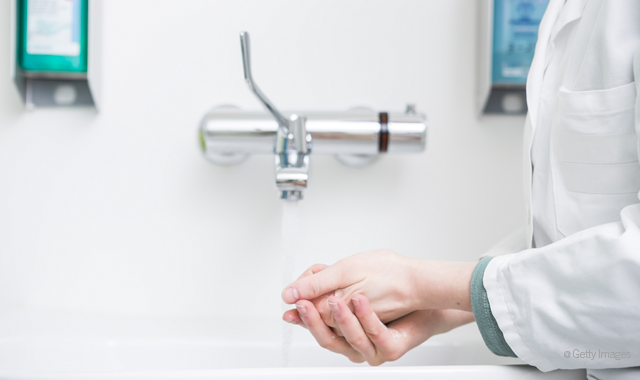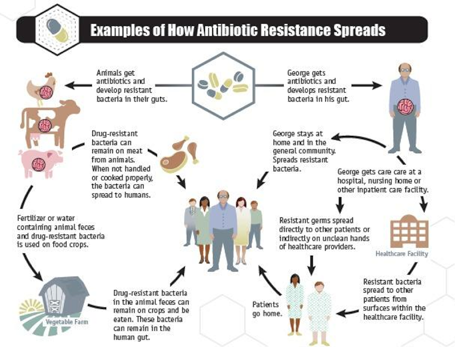The importance of battling antimicrobial resistance
Antimicrobial resistance is compromising our ability to treat infectious diseases, and fostering the rise of superbugs, bacteria that have become resistant to all known therapies. Antibiotic resistance refers specifically to bacteria’s resistance to antibiotics.

Antimicrobial resistance is compromising our ability to treat infectious diseases, and fostering the rise of superbugs, bacteria that have become resistant to all known therapies. Antibiotic resistance refers specifically to bacteria’s resistance to antibiotics.
Antimicrobial resistance is a broader term, referring to other microbes’ resistance to drugs used to treat infections. These include parasites (e.g. malaria), viruses (e.g. HIV) and fungi (e.g. Candida). More than two million people in the United States develop antibiotic-resistant infections, and at least 23,000 of them die as a result each year. This has caused several world and national health organizations to create guidelines to control the unnecessary use of antibiotics.
Both the World Health Organization (WHO) and the Centers for Disease Control (CDC) emphasize that infection prevention and limiting inappropriate antibiotic use are the most effective practices for controlling antibiotic resistance.
More from Diana Macri: How can you prevent violations of health and safety in the dental industry?
Disease prevention protocol
Every oral health care professional should be practicing standard precautions to protect themselves and their patients. The CDC guidelines stress:
- Handwashing- The single most effective means of stopping disease transmission; should be done for 15 seconds, every time gloves are removed and before gloves are placed on the hands. Hands should also be washed whenever they have touched a contaminated surface
- Use of personal protective equipment (PPE)- Mask, gloves, gown (or lab coat) and protective eye wear are to be worn EVERY time a provider treats a patient
- Strict adherence to appropriate sterilization and disinfection protocols
- Vaccinations- recommendations include HepB, MMR, Varicella, Tdap, meningococcal and annual influenza
And by all means, if you’re sick, stay home!

Trending article: Some of the worst infection control mistakes we've heard
Continue to page two for more...
Antibiotic premedication
All health care workers must strive to preserve the power of antimicrobial therapies and that includes preventing inappropriate prescribing and dispensing practices. According to WHO, “...staff lack up-to-date information, cannot identify the type of infection, [and/or] yield to patient pressure to prescribe antibiotics or benefit financially from supplying the medicines.” It is estimated by the CDC that half of antibiotics prescribed in the US are unnecessary or inappropriate for the symptoms reported. In 2014 the American Dental Association presented the findings of a panel of experts (the 2014 Panel) convened by the American Dental Association Council on Scientific Affairs. The panel “developed an evidence-based clinical practice guideline (CPG) on the use of prophylactic antibiotics in patients with prosthetic joints who are undergoing dental procedures. This CPG is intended to clarify the Prevention of Orthopaedic Implant Infection in Patients Undergoing Dental Procedures: Evidence-based Guideline and Evidence Report which was developed and published by the American Academy of Orthopaedic Surgeons and the American Dental Association (the 2012 Panel).” Their findings:
The current best evidence failed to demonstrate an association between dental procedures and prosthetic joint infection (PJI). In general, for patients with prosthetic joint implants, prophylactic antibiotics are not recommended prior to dental procedures to prevent prosthetic joint infection. The practitioner and patient should consider possible clinical circumstances that may suggest the presence of a significant medical risk in providing dental care without antibiotic prophylaxis, as well as the known risks of frequent or widespread antibiotic use.
Trending article: Dental care linked to risk of respiratory infections in ICU patients
Antibiotic premedication is reasonable for patients with:
- Prosthetic cardiac valve or prosthetic material used for cardiac valve repair
- A history of infective endocarditis
- A cardiac transplant that develops cardiac valvulopathy
- The following congenital (present from birth) heart disease: a unrepaired cyanotic congenital heart disease, including palliative shunts and conduits
- A completely repaired congenital heart defect with prosthetic material or device, whether placed by surgery or by catheter intervention, during the first six months after the procedure
- Any repaired congenital heart defect with residual defect at the site or adjacent to the site of a prosthetic patch or a prosthetic device (that inhibit endothelialization)
In my own office, I often have patients who are still pre-medicating for conditions such heart murmurs, knee replacements and mitral valve prolapse. Often, the only reason they are pre-medicating is because they are used to it and not because their orthopedist or cardiologist prescribed it. Even more troubling is the practice of dentists taking it upon themselves to premedicate a patient without consulting with the patient’s surgeon. Whether or not a patient needs to premedicate prior to dental procedures should be made by the patient’s surgeon and not the dentist.
Related reading: Hand sanitizer vs. handwashing: What dental professionals need to know
Continue to page three for more...
Antimicrobial rinses
Dental hygienists often recommend the use of antimicrobial/antiseptic rinses to prevent oral diseases such as dental caries and periodontal disease. Antimicrobial mouth rinses reduce the bacterial count and inhibit the bacterial activity in dental plaque; their efficacy has been well documented. The active ingredients in over the counter rinses are cetylpyridium chloride, essential oils (combinations of thymol, menthol, eucalyptol and methyl salicylate) and stannous fluoride. Many practices utilize chlorhexidine, a powerful antimicrobial, as an adjunct to manual biofilm/calculus removal therapies.
Chlorhexidine ruptures the bacterial cell membrane and binds salivary mucins, which reduces pellicle formation and is widely used in medicine, as well as dentistry, due to its broad activity spectrum, acceptable tolerability and favorable safety record. However, there is increasing concern that bacteria are forming a resistance to it.1 Conceivably, the use of chlorhexidine to combat oral disease may be contributing to this increase in resistance. In their systematic review, Jangid et al.2 reported comparable efficacy between herbal mouthwashes compared to chlorhexidine in preventing gingivitis. Interestingly, in their systematic review, Van Leeuwen et al.3 reported chlorhexidine was significantly better at controlling plaque but there was no significant difference with respect to reduction of gingivitis. Both studies concluded that herbal mouthrinses were a reliable alternative to chlorhexidine in reducing gingivitis (which is the first stage of periodontal disease).
Antimicrobial resistance is a serious global threat. As with all matters regarding public health, the concerted efforts of all will be necessary in order to preserve the potency of antimicrobials. Health care providers, including all oral health professionals, have taken on the responsibility of caring for the health of the population. Adhering to infection control guidelines and utilizing good judgment alongside sound scientific evidence will help to stop the spread of disease and, by extension, the unnecessary use of antimicrobials.
Sources
1. Horner, C., Mawer, D., & Wilcox, M. (2012). “Reduced susceptibility to chlorhexidine in staphylococci: is it increasing and does it matter?”Journal of Antimicrobial Chemotherapy. doi: 10.1093/jac/dks284
2. Jangid, K., Doraiswamy, J., Saji, V., Malaiappan, S. (2014). “Efficacy of Herbal Mouthwashes Compared to Chlorhexidine in Gingivitis-A Systematic Review”. International Journal of Ethnobiology and Ethnomedicine. 1 (1): 1-12.
3. Van Leeuwen, M. P. C., D. E. Slot, and G. A. Van der Weijden. (2011)."Essential oils compared to chlorhexidine with respect to plaque and parameters of gingival inflammation: a systematic review." Journal of Periodontology. 82 (2): 174-194.